|
THE ROOT OF THE POWERS OF FIRE
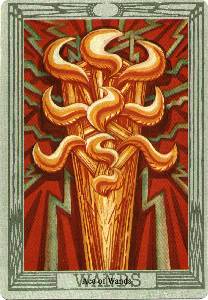 ACE OF WANDS ACE OF WANDS
This card represents the essence of the element of Fire in its
inception. It is a solar-phallic outburst of flame from which spring
lightnings in every direction.
These flames are Yods, arranged in the form of the Tree of Life.
(For Yod, see Atu IX supra.)
It is the primordial Energy of the Divine manifesting in Matter, at
so early a stage that it is not yet definitely formulated as Will.
Important: although these “small cards” are sympathetic with their
Sephirotic origin, they are not identical; nor are they Divine
Persons. These (and the Court Cards also) are primarily
sub-Elements, parts of the “Blind Forces” under the Demiourgos,
Tetragrammaton. Their rulers are the Intelligences, in the
Yetziratic world, who go to form the Schemhamphorasch. Nor is even
this Name, “Lord of the Universe” though it be, truly Divine, as are
the Lords of the Atu in the Element of Spirit. Each Atu possesses
its own private, personal and particular Universe, with Demiourgos
(and all the rest) complete, just as every man and every woman does.
For example II’s or VI’s Three of Disks might represent the
establishment of such an oracle as that of Delphi, or VIII’s might
be the first formula of a Code such as Manu gave to Hindustan; V’s,
a cathedral, XVI’s, a standing army; and so on. The great point is
that all the Elemental Forces, however sublime, powerful, or
intelligent, are Blind Forces and no more.
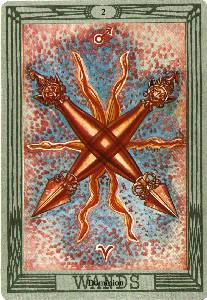 DOMINION TWO
OF WANDS DOMINION TWO
OF WANDS
This card, pertaining to Chokmah in the suit of Fire, represents the
Will in its most exalted form. It is an ideal Will, independent of
any given object.
“For pure will, unassuaged of purpose, delivered from the lust of
result, is every way perfect.” AL. 1. 44.
The background of this card shows the power of the planet
Mars in his own sign Aries, the first of the Signs. It there
represents Energy initiating a Current of Force.
The pictorial representation is two Dorjes crossed. The Dorje is the
Tibetan symbol of the thunderbolt, the emblem of celestial Power,
but more in its destructive than its creative form.
More, that is, in its earlier rather than its later form. For
destruction may be regarded as the first step in the creative
process. The virgin ovum must be broken in order to fertilize it.
Fear and repulsion are therefore the primary reaction to the
assault. Then, with understanding of the complete plan, willing
surrender rejoices to co-operate.
Six flames issue from the centre. This indicates the influence of
the Sun, who is exalted in Aries. This is the creative Will.
Mars in Aries is the attribution of the Geomantic Figure Puer. The
meaning of these figures is to be studied in the Handbook
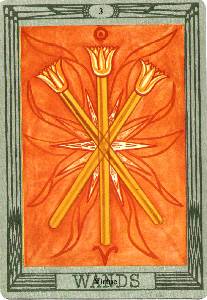 of that
science: “The Equinox” Vol. I, No.2. Remember that the Geomantic
Intelligences (see Liber 777 Cols. XLIX and
CLXXVIII) are all
primarily Gnomes. of that
science: “The Equinox” Vol. I, No.2. Remember that the Geomantic
Intelligences (see Liber 777 Cols. XLIX and
CLXXVIII) are all
primarily Gnomes.
VIRTUE THREE
OF WANDS
This card refers to Binah in the suit of Fire, and so represents the
establishment of primeval Energy. The Will has been transmitted to
the Mother, who conceives, prepares, and gives birth to, its
manifestation.
It refers to the Sun in Aries, the Sign in which he is exalted.
The meaning is harmonious, for this is the beginning of Spring. For
this reason one sees the wand taking the form of the Lotus in
blossom. The Sun has enkindled the Great Mother.
In the Yi King, Sol in Aries is represented by the 11th hexagram,
Thai; its meaning is identical with the above description.
COMPLETION
FOUR OF WANDS
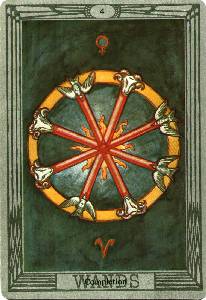
This card refers to Chesed in the suit of Fire. Being below the
Abyss, it is the Lord of all manifested active Power. The original
Will of the Two has been transmitted through the Three, and is now
built up into a solid system:-Order, Law, Government. It is also
referred to Venus in Aries, which indicates that one cannot
establish one’s work without tact and gentleness.
The wands are headed by the Ram, sacred to Chesed, the Father-god
Amoun-Ra, as also to Aries; but at the other end of the wands are
the Doves of Venus.
In the symbol, the ends of the wands touch a circle, showing the
completion and limitation of the original work. It is within this
circle that the flames (four double, as if to assert the balance) of
the Energy are seen to play, and there is no intention to increase
the scope of the original Will. But this limitation bears in itself
the seeds of disorder.
STRIFE
FIVE OF WANDS
This card is referred to Geburah of the suit of Fire. Geburah itself
being fiery, it is a purely active ,force. It is ruled also by
Saturn and Leo. Leo shows the element of Fire at its strongest and
most balanced. Saturn tends to weigh it down and to embitter it.
There is no limit to the scope of this volcanic energy.
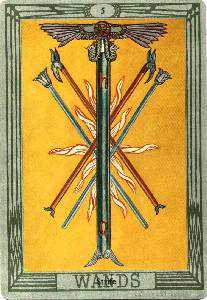
The symbol represents the wand of the Chief Adept, showing that the
authority is derived from the superiors; were it not so, this card
would be thoroughly disastrous. Moreover, there are also two wands
of the Second, or Major Adept. They have the head of the Phoenix,
which gives the idea of destruction (or rather purgation) through
fire, and the resurrection of the energy from its ashes.
There is also a pair of wands of the Third, or Minor, Adept, which
are daughters, so to speak, of the wands in the Three of Wands. In
this card there is the mitigating influence of the Mother. One of
the most difficult doctrines with regard to Geburah is that, while
it represents all this tameless irrational energy and disturbance,
yet it derives from the benign and gentle influence of the feminine.
The Egyptians understood this doctrine perfectly. Their Lion
goddess, Pasht, was hailed as “saeva” and “ferox”, was even called
“red in tooth and claw” by those fanatical devotees who wished to
identify her with Nature. The idea of sexual cruelty is often
inherent in the highest divine nature; compare Bhavani and Kali in
the Hindu system, and observe the Shiva-Sakti coition portrayed on
many Tibetan banners. See also Liber 418,4th, 3rd, and 2nd Aethyrs;
and the description supra of Atu XI.
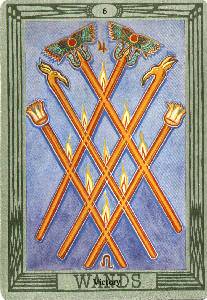
VICTORY SIX OF
WANDS
This card represents Tiphareth of the suit of Fire. This shows
Energy in completely balanced manifestation. The Five has broken up
the closed forces of the Four with revolutionary ardour, but a
marriage has taken place between them; and the result is the Son,
and the Sun.
The reference is also to Jupiter and Leo, which seems to imply a
benediction on the harmony and beauty of this arrangement. It Will
be seen that the Three Wands of the Three Adepts are now orderly
arranged; and the flames themselves, instead of shooting out in all
directions, burn steadily as in lamps. They are nine in number, in
reference to Yesod and the Moon. This shows the stabilization of the
Energy, and its reception and reflection by the Feminine. There is
no circle to enclose the system. It is self-supporting, like the
Sun.
VALOUR
SEVEN OF WANDS
This card derives from Netzach (Victory) in the suit of Fire. But
the Seven is a weak, earthy, feminine number as regards the
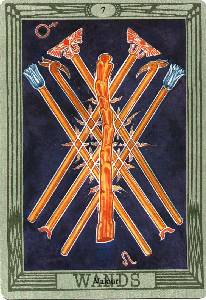 Tree of
Life, and represents a departure from the balance so low down on the
Tree that this implies a loss of confidence. Tree of
Life, and represents a departure from the balance so low down on the
Tree that this implies a loss of confidence.
Fortunately, the card is also attributed to Mars in Leo. Leo is
still the Sun in his full strength, but the marks of decadence are
already to be seen. It is as if the wavering fire summoned the
brutal energy of Mars to its support. But this is not enough to
counter- act fully the degeneration of the initial energy, and the
departure from equilibrium.
The army has been thrown into disorder; if victory is to be won, it
will be by dint of individual valour-a “soldiers’ battle”.
The pictorial representation shows the fixed and balanced wands of
the last card relegated to the background, diminished, and become
commonplace.
In front is a large crude uneven club, the first weapon to hand;
evidently unsatisfactory in ordered combat.
The flames are dispersed, and seem to attack in all directions
without systematic purpose.
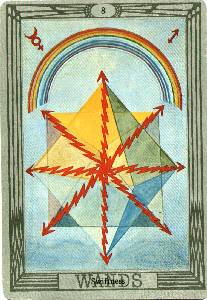 SWIFTNESS EIGHT OF WANDS SWIFTNESS EIGHT OF WANDS
The remaining three cards of the suit belong to Sagittarius, which
represents the subtilizing of the Fiery energy; and Mercury rules
the card, thus bringing down from Chokmah the message of the
original Will.
The card also refers to Hod, splendour, in the suit of Fire, whence
it refers to the phenomena of speech, light, electricity.
The pictorial representation of the card shows the Light-wands
turned into electrical rays, sustaining or even constituting Matter
by their vibrating energy. Above this restored universe shines the
rainbow; the division of pure light, which deals with maxima, into
the seven colours of the spectrum, which exhibit interplay and
correlation.
This card, therefore, represents energy of high velocity, such as
furnishes the master-key to modern mathematical physics.
It will be noted that there are no flames; they have all been taken
up into the wands to
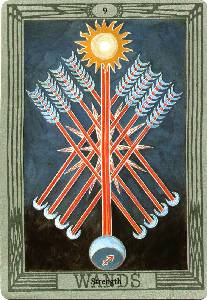 turn them into rays. On the other hand, the
electric energy has created intelligible geometrical form. turn them into rays. On the other hand, the
electric energy has created intelligible geometrical form.
STRENGTH
NINE OF WANDS
This card is referred to Yesod, the Foundation; this brings the
Energy back into balance. The Nine represents always the fullest
development of the Force in its relation with the Forces above it.
The Nine may be considered as the best that can be obtained from the
type involved, regarded from a practical and material standpoint.
This card is also governed by the Moon in Sagittarius; so here is a
double influence of the Moon on the Tree of Life. Hence the aphorism
“Change is Stability”.
The Wands have now become arrows. There are eight of them in the
background, and in front of them one master arrow. This has the Moon
for its point, and the Sun for the driving Force above it; for the
path of Sagittarius on the Tree of Life joins the Sun and Moon. The
flames in the card are tenfold, implying that the Energy is directed
downwards.
OPPRESSION TEN OF WANDS
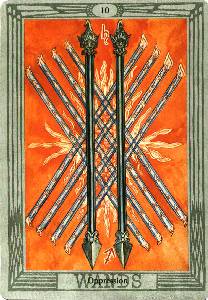
The number Ten refers to Malkuth, which depends from the other nine
Sephiroth, but is not directly in communication with them. It shows
the Force detached from its spiritual sources. It is become a blind
Force; so, the most violent form of that particular energy, without
any modifying influences. The flames in the background of the card
have run wild. It is Fire in its most destructive aspect.
The card also refers to the influence of Saturn in Sagittarius. Here
is the greatest antipathy. Sagittarius is spiritual, swift, light,
elusive, and luminous; Saturn is material, slow, heavy, obstinate,
and obscure.
The eight Wands are still crossed, showing the enormous power of the
completed energies of Fire; but they have lost their patents of
nobility. Their ends seem more like claws; they lack the authority
and intelligence shown in the earlier cards; and in front are the
two formidable Dorjes of the Two of Wands, but lengthened to bars.
The whole picture suggests Oppression and repression. It is a stupid
and obstinate
cruelty from which there is no escape. It is a Will which has not
understood anything
beyond its du]l purpose,
its “lust of result”, and will devour itself in the conflagrations
it has evoked.
Go Back
THE ROOT OF THE POWERS OF
WATER
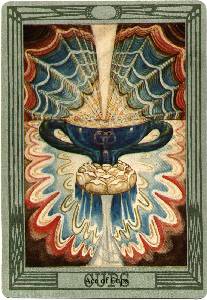 ACE OF CUPS ACE OF CUPS
This card represents the element of Water in its most secret and
original form. It is the feminine complement of the Ace of Wands,
and is derived from the Yoni and the Moon exactly as that is from
the Lingam and the Sun. The third in the Hierarchy. This accordingly
represents the essential form of the Holy Grail. Upon the dark sea
of Binah, the Great Mother, are Lotuses, two in one, which fill the
cup with the Life-fluid, symbolically represented either as Water,
as Blood, or as Wine, according to the selected purpose of the
symbolism. This being a primordial card, the liquid is shown as
water; it can be transformed into Wine or Blood as may be required.
Above the Cup, descending upon it, is the Dove of the Holy Ghost,
thus consecrating the element.
At the base of the Cup is the Moon, for it is the virtue of this
card to conceive and to produce the second form of its Nature.
LOVE TWO
OF CUPS
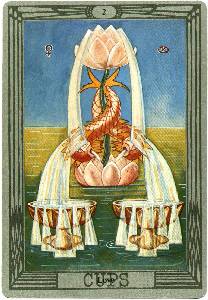 The Two always represents the Word and the Will. It is the first
manifestation. Therefore, in the suit of Water, it must refer to
Love, which recovers unity from dividuality by mutual annihilation. The Two always represents the Word and the Will. It is the first
manifestation. Therefore, in the suit of Water, it must refer to
Love, which recovers unity from dividuality by mutual annihilation.
The card also refers to Venus in Cancer. Cancer is, more than any
other, the receptive Sign; it is the House of the Moon, and in that
Sign Jupiter is exalted. These are, superficially, the three most
friendly of the planets.
The hieroglyph of the card represents two cups in the foreground,
overflowing upon
a calm sea. They are fed with lucent water from a lotus floating
upon the sea, from
which rises another lotus around whose stem are entwined twin
dolphins. The
symbolism of the dolphin is very complicated, and must be studied in
books of
reference; but the general idea is that of the “Royal Art”. The
dolphin is peculiarly
sacred to Alchemy.
The number Two referring to Will, this card might really be renamed
the Lord of Love under Will, for that is its full and true meaning.
It shows the harmony of the male and the female: interpreted in the
largest sense. It is perfect and placid harmony, radiating an
intensity of joy and ecstasy.
Of necessity, the realization of the idea in the Four (as the suit
develops) will gradually diminish the purity of its perfection.
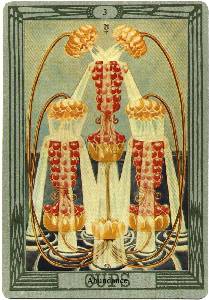
ABUNDANCE THREE OF CUPS
This card refers to Binah in the suit of Water. This is the card of
Demeter or Persephone. The Cups are pomegranates: they are filled
bountifully to overflowing from a single lotus, arising from the
dark calm sea characteristic of Binah. There is here the fulifilment
of the Will of Love in abounding joy. It is the spiritual basis of
fertility.
The card is referred to the influence of Mercury in Cancer; this
carries further the above thesis. Mercury is the Will or Word of the
All-Father; here its influence descends upon the most receptive of
the Signs.
At the same time, the combination of these forms of energy brings in
the possibility of somewhat mysterious ideas. Binah, the Great Sea,
is the Moon in one aspect, but Saturn in another; and Mercury,
besides being the Word or Will of the All-One, is the guide of the
souls of the Dead. This card requires great subtlety of
interpretation.
The pomegranate was the fruit which Persephone ate in the realms of
Pluto, thereby
enabling him to hold her in the lower world, even after the most
powerful influence
had been brought to bear. The lesson seems to be that the good
things of life, although enjoyed, should be distrusted.
LUXURY
FOUR OF CUPS
This card refers to Chesed in the sphere of Water. Here, below the
Abyss, the energy of this element, although ordered, balanced and
(for the moment) stabilized, has lost the original purity of the
conception.
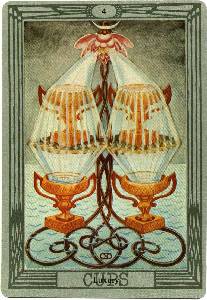
The card refers to the Moon in Cancer, which is her own house; but
Cancer itself is so placed that this implies a certain weakness, an
abandonment to desire. This tends to introduce the seeds of decay
into the fruit of pleasure.
The sea is still shown, but its surface is ruffled, and the four
Cups which stand upon it are no longer so stable. The Lotus from
which the water Springs has a multiple stem, as if to show that the
influence of the Dyad has gathered strength. For although the number
Four is the manifestation and consolidation of the dyad, it is also
secretly preparing catastrophe by emphasizing individuality.
There is a certain parallelism between this card and the Geomantic
figures Via and Populus, which are attributed to the Moon in her
decrease and increase respectively. The link is primarily the
“Change=Stability” equation, already familiar to readers of this
essay. Four is an “awkward” number; alone among the natural numbers,
it is impossible to construct a “Magic Square” of four cells. Even
in the Naples Arrangement, Four is a dead stop, a blind alley. An
idea of a totally different Order is necessary to carry on the
series. Note also the refolding-in-upon-itself suggested by the
“Magic Number” of Four 1+2 + 3+4 which is Ten. Four is the number of
the Curse of Limitation, of Restriction. It is the blind and barren
Cross of equal arms, Tetragrammaton in his fatal aspect of finality,
as the Qabalists knew him before the discovery of the Revolving
Formula whereby the Daughter, seated upon the Throne of the Mother,
“awakens the Eld of the All-Father”.
For the meanings of Via and Populus, refer to the “Handbook of
Geomancy” (Equinox Vol. I, No.2).
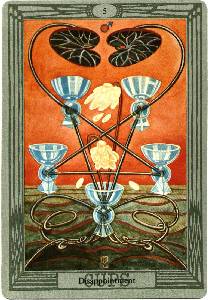 DISAPPOINTMENT FIVE OF CUPS DISAPPOINTMENT FIVE OF CUPS
This card is ruled by Geburah in the suit of Water. Geburah being
fiery, there is a natural antipathy. Hence arises the idea of
disturbance, just when least expected, in a time of ease.
The attribution is also to Mars in Scorpio, which is his own house;
and Mars is the manifestation on the lowest plane of Geburah, while
Scorpio, in its worst aspect, suggests the putrefying power of
Water. Yet the powerful male influences do not show actual decay,
only the beginning of destruction; hence, the anticipated pleasure
is frustrated. The Lotuses have their petals torn by fiery winds;
the sea is arid and stagnant, a dead sea, like a “chott” in North
Africa. No water flows into the cups.
Moreover, these cups are arranged in the form of an inverted
pentagram, symbolizing the triumph of matter over spirit.
Mars in Scorpio, moreover, is the attribution of the Geomantic
figure Rubeus. This is of such evil omen that certain schools of
Geomancy destroy the Map, and postpone the question for two hours or
more, when Rubeus appears in the Ascendant. Its meaning is to be
studied in the “Handbook of Geomancy” (Equinox Vol. I, No.2).
PLEASURE SIX OF CUPS
This card shows the influence of the number Six, Tiphareth, in the
suit of Water. This influence is fortified by that of the Sun,
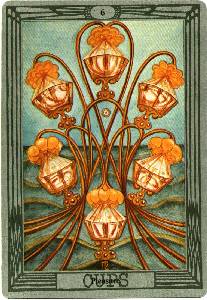 who
also represents the Six. The whole image is that of the influence of
the Sun on Water. His fierce, but balanced power operates that type
of putrefaction-he is in the Sign of Scorpio-which is the basis of
all fertility, all life. who
also represents the Six. The whole image is that of the influence of
the Sun on Water. His fierce, but balanced power operates that type
of putrefaction-he is in the Sign of Scorpio-which is the basis of
all fertility, all life.
The lotus stems are grouped in an elaborate dancing movement. From
their blossoms water gushes into the Cups, but they are not yet full
to overflowing, as they are in the corresponding card below; the
Nine.
Pleasure, in the title of this card, must be understood in its
highest sense: it implies well-being, harmony of natural forces
without effort or strain, ease, satisfaction. Foreign to the idea of
the card is the gratification of natural or artificial desires. Yet
it does represent emphatically the fulfilment of the sexual Will, as
shown by the ruling Sephira, planet, element, and sign.
In the Yi King, Sol in Scorpio is represented by the 20th Hexagram,
Kwan, which is also “Big Earth”, being the Earth Trigram with
doubled lines. Kwan means “manifesting”, but also “contemplating”.
The Kwan refers directly to an High Priest, ceremonially purified,
about to present his offerings. The idea of Pleasure-Putrefaction as
a Sacrament is therefore implicit in this Hexagram as in this card;
while the comments on the separate lines by the Duke of Chau
indicate the analytical value of this Eucharist. It is one of the
master-keys to the Gate of Initiation. To realize and to enjoy this
fully it is necessary to know, to understand, and to experience, the
Secret of the Ninth Degree of the O.T.O.
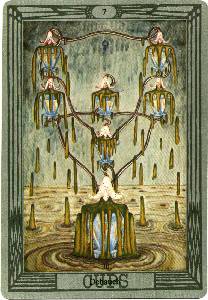 DEBAUCH
SEVEN OF CUPS DEBAUCH
SEVEN OF CUPS
This card refers to the Seven, Netzach, in the suit of Water. Here
recurs the invariable weakness arising from lack of balance; also,
the card is governed by Venus in Scorpio. Her dignity is not good in
this Sign; one is reminded that Venus is the planet of Copper,
“external splendour and internal corruption”. The Lotuses have
become poisonous, looking like tiger-lilies; and, instead of water,
green slime issues from them and overflows, making the Sea a
malarious morass. Venus redoubles the influence of the number Seven.
The cups are iridescent, carrying out the same idea.
They are arranged as two descending triangles interlaced above the
lowest cup, which is very much larger than the rest.
This card is almost the “evil and averse” image of the Six; it is a
wholesome reminder of the fatal ease with which a Sacrament may be
profaned and prostituted.
Lose direct touch with Kether, the Highest; diverge never so little
from the delicate balance of the Middle Pillar; at once the holiest
mysteries of Nature become the obscene and shameful secrets of a
guilty conscience.
INDOLENCE EIGHT OF CUPS
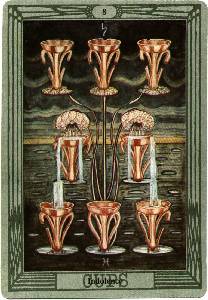 The Eight, Hod, in the suit of Water, governs this card. It shows
the influence of Mercury, but this is overpowered by the reference
of the card to Saturn in Pisces. Pisces is calm but stagnant water;
and Saturn deadens it completely. Water appears no longer as the Sea
but as pools; and there is no florescence in this card as there was
in the last. The Lotuses droop for lack of sun and rain, and the
soil is poison to them; only two of the stems show blossoms at all.
The cups are shallow, old and broken. The Eight, Hod, in the suit of Water, governs this card. It shows
the influence of Mercury, but this is overpowered by the reference
of the card to Saturn in Pisces. Pisces is calm but stagnant water;
and Saturn deadens it completely. Water appears no longer as the Sea
but as pools; and there is no florescence in this card as there was
in the last. The Lotuses droop for lack of sun and rain, and the
soil is poison to them; only two of the stems show blossoms at all.
The cups are shallow, old and broken.
They are arranged in three
rows; of these the upper row of three is quite empty. Water trickles
from the two flowers into the two central cups, and they drip into
the two lowest without filling them. The background of the card
shows pools, or lagoons, in very extensive country, incapable of
cultivation; only disease and miasmatic poison can flourish in those
vast Bad Lands.
The water is dark and muddy. On the horizon is a pallid, yellowish
light, weighed down by leaden clouds of indigo.
Compare with the last card; it represents the opposite and
complementary error. The one is the Garden of Kundry, the other the
Palace of Klingsor.
In the psychopathology of The Path, this card is the German Measles
of Christian Mysticism.
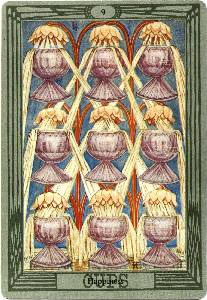 HAPPINESS NINE OF CUPS HAPPINESS NINE OF CUPS
The Number Nine, Yesod, in the suit of Water, restores the stability
lost by the excursions of Netzach and Hod from the Middle Pillar. It
is also the number of the Moon, thus strengthening the idea of
Water.
In this card is the pageant of the culmination and perfection of the
original force of Water.
The Ruler is Jupiter in Pisces. This influence is more than
sympathetic; it is a definite benediction, for Jupiter is the planet
of Chesed which represents Water in its highest material
manifestation, and Pisces brings out the placid qualities of Water.
In the symbol are nine cups perfectly arranged in a square; all are
filled and overflowing with Water. It is the most complete and most
beneficent aspect of the force of Water.
The Geomantic Figure Laetitia is ruled by Jupiter in Pisces. For its
meaning consult the “Handbook of Geomancy” (Equinox Vol I, No.2).
Laetitia, Joy, gladness, is one of the best and most powerful of the
sixteen figures; for the Solar, Lunar, and Mercurial symbols are, at
the best, ambiguous and treacherously ambivalent; those of Venus
portend rather relief than positive beneficence; Saturn and Mars are
seen at their worst; and even the stable-companion of Laetitia,
Acquisitio, has its unpleasant aspects, and even its dangers. But
the consonance of Laetitia with this card amounts to little less
than an identity; the wine is poured by Ganymede himself, unstinted
vintage of true nectar of the Gods, brimful and running over, an
ordered banquet of delight, True Wisdom self-fulfilled in Perfect
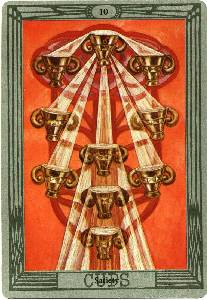 Happiness. Happiness.
SATIETY
TEN OF CUPS
This card represents a conflicting element. On the one hand, it
receives the influence
of the Ten, Malkah the Virgin. The arrangement of the cups is that
of the Tree of
Life. But, on the other hand, they are themselves unstable. They are
tilted; they spill
the water from the great Lotus which overhangs the whole system from
one into the other.
The work proper to water is complete: and disturbance is due.
This comes from the influence of Mars in Pisces. Mars is the gross,
violent and disruptive force which inevitably attacks every supposed
perfection. His energy displays the greatest possible contrast with
that of Pisces, which is both peaceful and spiritualized.
Go Back
THE ROOT OF THE POWERS OF
AIR
ACE OF
SWORDS
The Ace of Swords is the primordial Energy of Air, the Essence of
the Vau of Tetragrammaton, the integration of the Ruach. Air is the
result of the conjunction of Fire and Water; thus it lacks the
purity of its superiors in the male hierarchy, Fire, Sol and the
Phallus. But for this same reason it is the first card directly to
be apprehended by the normal consciousness of
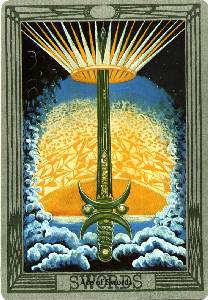 Mankind. The errors of
such cards as the 7 and 10 of Cups are yet of an Order altogether
higher than the apparently much milder 4 of Swords. The study of the
subtle and gradual degradation of the planes is excessively
difficult. Mankind. The errors of
such cards as the 7 and 10 of Cups are yet of an Order altogether
higher than the apparently much milder 4 of Swords. The study of the
subtle and gradual degradation of the planes is excessively
difficult.
In nature, the obvious symbol of Air is the Wind “which bloweth
whithersoever it listeth”. It lacks the concentrated Will of Fire to
unite with Water: it has no corresponding passion for its Twin
Element, Earth. There is indeed, a notable passivity in its nature;
evidently, it has no self-generated impulse. But, set in motion by
its Father and Mother, its power is manifestly terrific. It visibly
attacks its objective, as they, being of subtler and more tenuous
character, can never do. Its “all-embracing, all-wandering,
all-penetrating, all-consuming” qualities have been described by
many admirable writers, and its analogies are for the most part
patent to quite ordinary observers.
But, it will instantly be asked, what of the status of this Element
in the light of other attributions? In the Yetziratic World, is not
Air the first element to follow Spirit? Is not Vayu the first
emergence of the phenomenal from the arcane obscurity of Akasha? How
may one reconcile the doctrine of Mind with the fact that Ruh, or
Ruach, actually means Spirit itself? “Achath Ruach Elohim Chiim”
(777) means “One is the Spirit (not Air) of the Gods of the Living”?
And is not Air, the element attributed to Mercury, also most
properly the Breath of Life, the Word, the Logos itself?
The student must be referred to some less raw, cursory, elementary
and superficial Treatise than this present bat-eyed, penguin-
winged, bluebottle-brained buzzing. Nevertheless, although Air is in
no system the lowest, and so cannot claim benefit of clergy from the
doctrine that Malkuth automatically resolves into Kether, the
following reference seems not wholly to lack either cogency or
pertinence.
The Ruach is centred in the airy Sephira, Tiphareth, who is the Son,
the first-born of the Father, and the Sun, the first emanation of
the creative Phallus. He derives directly from his mother Binah
through the Path of Zain, the sublime intuitive sense, so that he
partakes absolutely of the nature of Neschamah. From his father,
Chokmah, he is informed though the Path of Heh’, the Great Mother,
the Star, our Lady Nuit, so that the creative impulse is
communicated to him by all possibilities soever. [How strikingly
this fact confirms the counterchange of IV and XVII, above fully
expounded: as a link between Chokmah and Tiphareth, the Emperor
would have no great significance, and this exquisite doctrine of the
Three Mothers would be lost.]
Finally, from Kether, the supreme, descends directly upon him,
though the Path of
Gimel, the High Priestess, the triune light of Initiation. The
Three- in-One, the Secret Mother in her polymorphous plenitude;
these, these alone, hail him thrice blessed of the Supernals!
The card represents the Sword of the Magus (see Book 4, Part II)
crowned with the twenty-two rayed diadem of pure Light. The number
refers to the Atu; also 22=2 X II, the Magical manifestation of
Chokmah, Wisdom, the Logos. Upon the blade, accordingly, is
inscribed the Word of the Law, This Word sends forth a blaze of
Light, dispersing the dark clouds of the Mind.
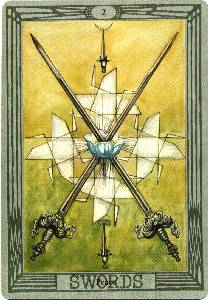
PEACE
TWO OF SWORDS
This card is ruled by Chokmah in the Element of Air. This suit,
governing all intellectual manifestations, is always complicated and
disordered. It is subject to change as is no other suit. It
represents a general shaking-up, resulting from the conflict of Fire
and Water in their marriage; and proceeds, when Earth appears, to
crystallization. But the purity and exaltation of Chokmah are such
that this card manifests the very best idea possible to the suit.
The energy abides above the onslaught of disruption. This
comparative calm is emphasized by the celestial attribution: the
Moon in Libra.
The Moon is change, but Nature is peaceful; moreover, Libra
represents balance; between them, they regulate the energy of the
Swords.
In the card appear two swords crossed; they are united by a blue
rose with five petals. This rose represents the influence of the
Mother, whose harmonizing influence compounds the latent antagonism
native to the suit. The Rose emits white rays, producing a
geometrical pattern that emphasizes the equilibrium of the symbol.
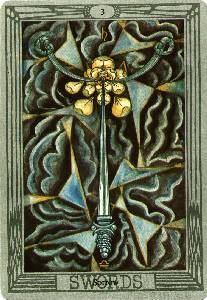 SORROW
THREE OF SWORDS SORROW
THREE OF SWORDS
Binah, the Great Mother, here rules the realm of Air. This fact
involves an extremely difficult doctrine which must be studied at
length in The Vision and the Voice: Aethyr 14.
Binah is here not the beneficent Mother completing the Trinity with
Kether and Chokmah. She represents the darkness of the Great Sea.
This is accentuated by the Celestial Lordship of Saturn in Libra.
This card is dark and heavy; it is, so to speak, the womb of Chaos.
There is an intense lurking passion to create, but its children are
monsters. This may mean the supreme transcendence of the natural
order. Secrecy is here, and Perversion.
The symbol represents the great Sword of the Magician, point
uppermost; it cuts the junction of two short curved swords. The
impact has destroyed the rose. In the background, storm broods under
implacable night.
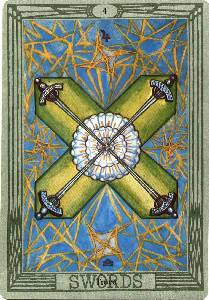
TRUCE
FOUR OF SWORDS
The number Four, Chesed, is here manifested in the realm of the
Intellect. Chesed
refers to Jupiter who rules in Libra in this decanate. The sum of
these symbols is
therefore without opposition; hence the card proclaims the idea of
authority in the
intellectual world. It is the establishment of dogma, and law
concerning it. It
represents a refuge from mental chaos, chosen in an arbitrary
manner. It argues for convention.
The hilts of the four Swords are at the corner of a St. Andrew’s
cross. Their shape suggests fixation and rigidity. Their points are
sheathed---in a rather large rose of forty-nine petals representing
social harmony. Here, too, is compromise.
Minds too indolent or too cowardly to think out their own problems
hail joyfully this policy of appeasement. As always, the Four is the
term; as in this case there is no true justification for repose, its
disturbance by the Five holds no promise of advance; its static
shams go pell-mell into the melting-pot; the issue is mere mess,
usually signalized by foetid stench. But it has to be done!
 DEFEAT
FIVE OF SWORDS DEFEAT
FIVE OF SWORDS
Geburah, as always, produces disruption; but as Venus here rules
Aquarius, weakness rather than excess of strength seems the cause of
disaster. The intellect has been enfeebled by sentiment. The defeat
is due to pacifism. Treachery also may be implied.
The hilts of the swords form the inverted pentagram, always a symbol
of somewhat sinister tendency. Here matters are even worse; none of
the hilts resembles any of the others, and their blades are crooked
or broken. They give the impression of drooping; only the lowest of
the swords points upwards, and this is the least effective of the
weapons. The rose of the previous card has been altogether
disintegrated.
The historian is happy to observe two perfect illustrations of the
mode of this card and the last in the birth of the Aeon of (1)
Osiris, (2) Horus. He will note the decay of such Virtue as
characterized Sparta and Rome, ending in the establishment of the
Pax Romana. As Virtue declined, corruption disintegrated the Empire
from within. Epicene cults, such as those of Dionysus (in its
degraded form), of Attis, of Adonis, of Cybele, the false Demeter
and the prostituted Isis, replaced the sterner rites of the true
Solar- Phallic gods; until finally (the masters having lost the
respect, and so the control, of the plebs, native and alien) the
lowest of all the slave-cults, dressed up in the fables of the
vilest of the parasitic races, swept
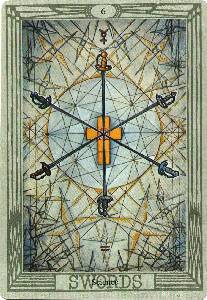 over the known world, and
drenched it in foul darkness for five hundred years. He will delight
to draw close parallels with the cognate phenomena displayed before
the present generation. over the known world, and
drenched it in foul darkness for five hundred years. He will delight
to draw close parallels with the cognate phenomena displayed before
the present generation.
SCIENCE
SIX OF SWORDS
Tiphareth shows the full establishment and balance of the idea of
the suit. This is particularly the case with this card, as the
intellect itself is also referred to the number Six. Mercury, in
Aquarius, represents the celestial Energy influencing the Kerub of
the Man, thus showing intelligence and humanity.
But there is much more than this in the symbol. The perfect balance
of all mental and moral faculties, hardly won, and almost impossible
to hold in an ever-changing world, declares the idea of Science in
its fullest interpretation.
The hilts of the Swords, which are very ornamental, are in the form
of the hexagram. Their points touch the outer petals of a red rose
upon a golden cross of six squares, thus showing the Rosy Cross as
the central secret of scientific truth.
FUTILITY
SEVEN OF SWORDS
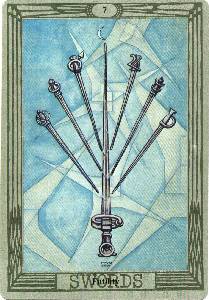
Netzach, in the suit of Swords, does not represent such catastrophe
as in the other suits, for Netzach, the Sephira of Venus, means
victory. There is, therefore, a modifying influence; and this is
accentuated by the celestial rule of the Moon in Aquarius.
The intellectual wreckage of the card is thus not so vehement as in
the Five. There is vacillation, a wish to compromise, a certain
toleration. But, in certain circumstances, the results may be more
disastrous than ever. This naturally depends upon the success of the
policy. This is always in doubt as long as there exist violent,
uncompromising forces which take it as a natural prey.
This card, like the Four, suggests the policy of appeasement.
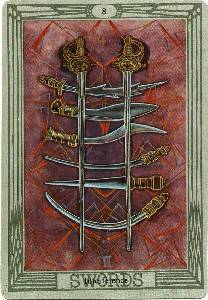 The symbol shows six Swords with their hilts in crescent formation.
Their points meet below the centre of the card, impinging upon a
blade of a much larger up-thrusting sword, as if there were a
contest between the many feeble and the one strong. He strives in
vain. The symbol shows six Swords with their hilts in crescent formation.
Their points meet below the centre of the card, impinging upon a
blade of a much larger up-thrusting sword, as if there were a
contest between the many feeble and the one strong. He strives in
vain.
INTERFERENCE EIGHT OF SWORDS
The number Eight, Hod, here signifies lack of persistence in matters
of the intellect and of contest. Good fortune, however, attends even
these weakened efforts, thanks to the influence of Jupiter in
Gemini, ruling the Decan. Yet the Will is constantly thwarted by
accidental interference.
The centre of the card is occupied by two long Swords pointed
downward. These are crossed by six small swords, three on each side.
They remind one of weapons peculiar to their countries or their
cults; we see here the Kriss, the Kukri, the Scramasax, the Dagger,
the Machete and the Yataghan.
CRUELTY
NINE OF SWORDS
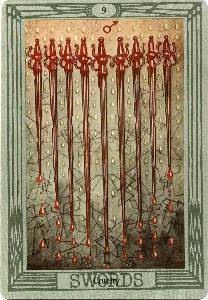
The number Nine, Yesod, brings back the Energy to the central pillar
of the Tree of Life. The previous disorder is now rectified.
But the general idea of the suit has been constantly degenerating.
The Swords no longer represent pure intellect so much as the
automatic stirring of heartless passions. Consciousness has fallen
into a realm unenlightened by reason. This is the world of the
unconscious primitive instincts, of the psychopath, of the fanatic.
The celestial ruler is Mars in Gemini, crude rage of hunger
operating without restraint; although its form is intellectual, it
is the temper of the inquisitor.
The symbol shows nine swords of varying lengths, all striking
downwards to a point.
They are jagged and rusty. Poison and blood drip from their blades.
There is, however, a way of dealing with this card: the way of
passive resistance, resignation, the acceptance of martyrdom.
Nor is an alien formula that of implacable revenge.
RUIN TEN
OF SWORDS
The number Ten, Malkuth, as always, represents the culmination of
the unmitigated energy of the idea. It shows reason run mad,
ramshackle riot of soulless mechanism; it represents the logic of
lunatics and (for the most part) of philosophers. It is
 reason
divorced from reality. reason
divorced from reality.
The card is also ruled by the Sun in Gemini, but the mercurial airy
quality of the Sign serves to disperse his rays; this card shows the
disruption and disorder of harmonious and stable energy.
The hilts of the Swords occupy the positions of the Sephiroth, but
the points One to Five and Seven to Nine touch and shatter the
central Sword (six) which represents the Sun, the Heart, the child
of Chokmah and Binah. The tenth Sword is also in splinters. It is
the ruin of the Intellect, and even of all mental and moral
qualities.
In the Yi King, Sol in Gemini is the virtue of the 43rd Hexagram,
Kwai, the Watery modification of the Phallus; also, by the
interlacing interpretation, the harmony of these two same Trigrams.
The signification is perfectly harmonious with that of the Ten of
Swords It represents the damping down of the Creative impulse,
weakness, corruption, or mirage affecting that principle itself.
But, viewing the Hexagram as a weapon or method of procedure, it
counsels the ruler to purge the state of unworthy officers.
Curiously, the invention of written characters to replace knotted
strings is ascribed among Chinese scholars to the use of this
hexagram by the sages. Gemini is ruled by Thoth;
10 is the key of the Naples Arrangement; and Apollo (Sol) is the
patron of literature and the arts: so his suggestion might appear at
least no less suitable to the Qabalistic correspondences than to
their double emphasis on Water and the Sun.
Apart from this, however, the parallelism is complete.
Go Back
|
 ACE OF WANDS
ACE OF WANDS  DOMINION TWO
OF WANDS
DOMINION TWO
OF WANDS  of that
science: “The Equinox” Vol. I, No.2. Remember that the Geomantic
Intelligences (see Liber 777 Cols. XLIX and
CLXXVIII) are all
primarily Gnomes.
of that
science: “The Equinox” Vol. I, No.2. Remember that the Geomantic
Intelligences (see Liber 777 Cols. XLIX and
CLXXVIII) are all
primarily Gnomes. 


 Tree of
Life, and represents a departure from the balance so low down on the
Tree that this implies a loss of confidence.
Tree of
Life, and represents a departure from the balance so low down on the
Tree that this implies a loss of confidence.
 SWIFTNESS EIGHT OF WANDS
SWIFTNESS EIGHT OF WANDS
 turn them into rays. On the other hand, the
electric energy has created intelligible geometrical form.
turn them into rays. On the other hand, the
electric energy has created intelligible geometrical form. 
 ACE OF CUPS
ACE OF CUPS
 The Two always represents the Word and the Will. It is the first
manifestation. Therefore, in the suit of Water, it must refer to
Love, which recovers unity from dividuality by mutual annihilation.
The Two always represents the Word and the Will. It is the first
manifestation. Therefore, in the suit of Water, it must refer to
Love, which recovers unity from dividuality by mutual annihilation.


 DISAPPOINTMENT FIVE OF CUPS
DISAPPOINTMENT FIVE OF CUPS
 who
also represents the Six. The whole image is that of the influence of
the Sun on Water. His fierce, but balanced power operates that type
of putrefaction-he is in the Sign of Scorpio-which is the basis of
all fertility, all life.
who
also represents the Six. The whole image is that of the influence of
the Sun on Water. His fierce, but balanced power operates that type
of putrefaction-he is in the Sign of Scorpio-which is the basis of
all fertility, all life.
 DEBAUCH
SEVEN OF CUPS
DEBAUCH
SEVEN OF CUPS  The Eight, Hod, in the suit of Water, governs this card. It shows
the influence of Mercury, but this is overpowered by the reference
of the card to Saturn in Pisces. Pisces is calm but stagnant water;
and Saturn deadens it completely. Water appears no longer as the Sea
but as pools; and there is no florescence in this card as there was
in the last. The Lotuses droop for lack of sun and rain, and the
soil is poison to them; only two of the stems show blossoms at all.
The cups are shallow, old and broken.
The Eight, Hod, in the suit of Water, governs this card. It shows
the influence of Mercury, but this is overpowered by the reference
of the card to Saturn in Pisces. Pisces is calm but stagnant water;
and Saturn deadens it completely. Water appears no longer as the Sea
but as pools; and there is no florescence in this card as there was
in the last. The Lotuses droop for lack of sun and rain, and the
soil is poison to them; only two of the stems show blossoms at all.
The cups are shallow, old and broken.
 HAPPINESS NINE OF CUPS
HAPPINESS NINE OF CUPS
 Happiness.
Happiness.  Mankind. The errors of
such cards as the 7 and 10 of Cups are yet of an Order altogether
higher than the apparently much milder 4 of Swords. The study of the
subtle and gradual degradation of the planes is excessively
difficult.
Mankind. The errors of
such cards as the 7 and 10 of Cups are yet of an Order altogether
higher than the apparently much milder 4 of Swords. The study of the
subtle and gradual degradation of the planes is excessively
difficult.

 SORROW
THREE OF SWORDS
SORROW
THREE OF SWORDS 
 DEFEAT
FIVE OF SWORDS
DEFEAT
FIVE OF SWORDS  over the known world, and
drenched it in foul darkness for five hundred years. He will delight
to draw close parallels with the cognate phenomena displayed before
the present generation.
over the known world, and
drenched it in foul darkness for five hundred years. He will delight
to draw close parallels with the cognate phenomena displayed before
the present generation. 
 The symbol shows six Swords with their hilts in crescent formation.
Their points meet below the centre of the card, impinging upon a
blade of a much larger up-thrusting sword, as if there were a
contest between the many feeble and the one strong. He strives in
vain.
The symbol shows six Swords with their hilts in crescent formation.
Their points meet below the centre of the card, impinging upon a
blade of a much larger up-thrusting sword, as if there were a
contest between the many feeble and the one strong. He strives in
vain. 
 reason
divorced from reality.
reason
divorced from reality.